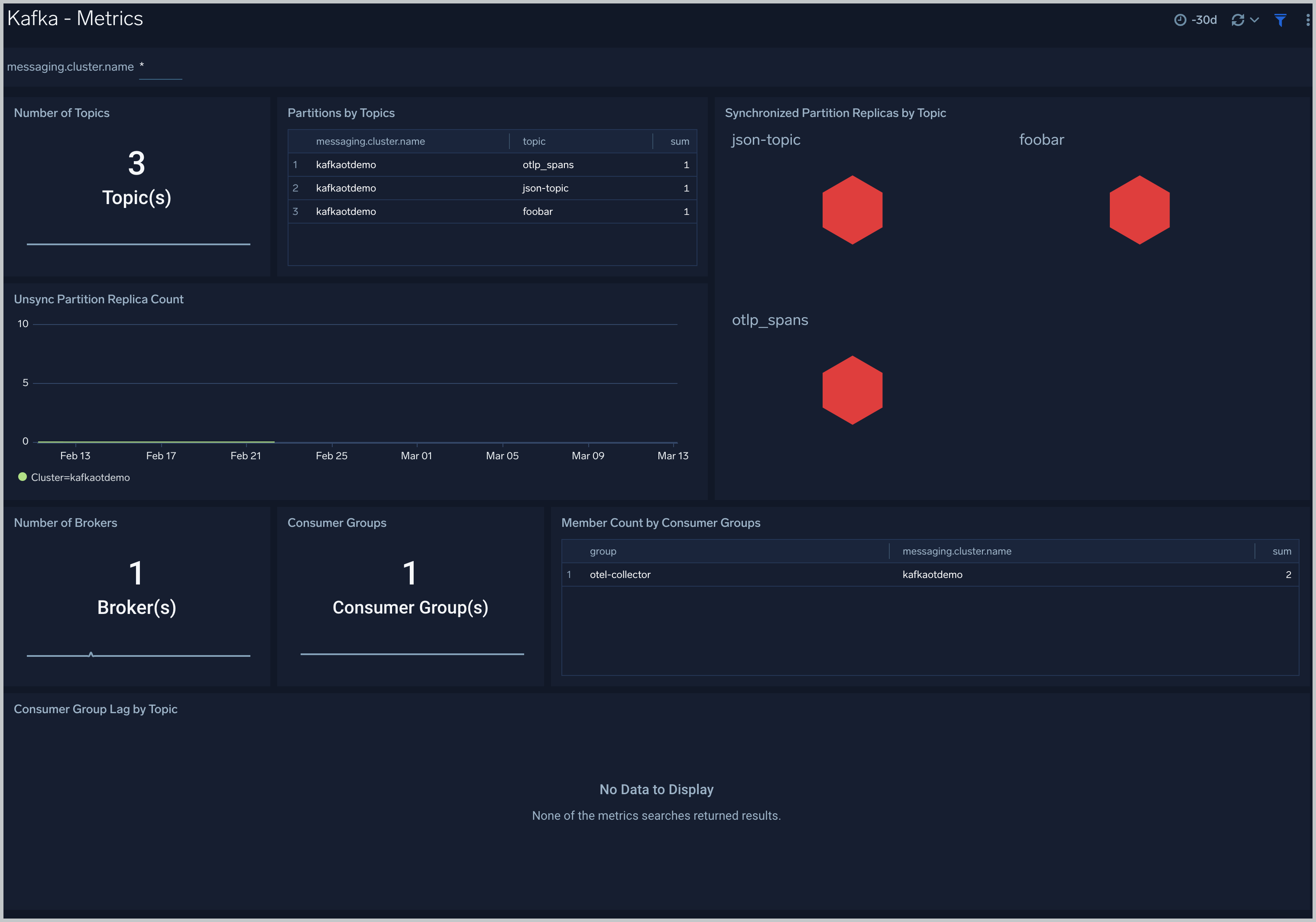Kafka - OpenTelemetry Collector

The Sumo Logic App for Kafka is a unified logs and metrics app. The app helps you monitor the brokers, partition replicas and consumer groups components of Kafka messaging/streaming clusters. Pre-configured dashboards provide insights into the broker operations, topics, replication and error logs.
We use the OpenTelemetry collector for Kafka metrics and logs collection.
The diagram below illustrates the components of the Kafka collection for each Kafka broker node. OpenTelemetry collector runs on the same host as Kafka, and uses the Kafka Receiver to obtain Kafka metrics, and the Sumo Logic OpenTelemetry Exporter to send the metrics to Sumo Logic. Kafka logs are sent to Sumo Logic through a filelog receiver.
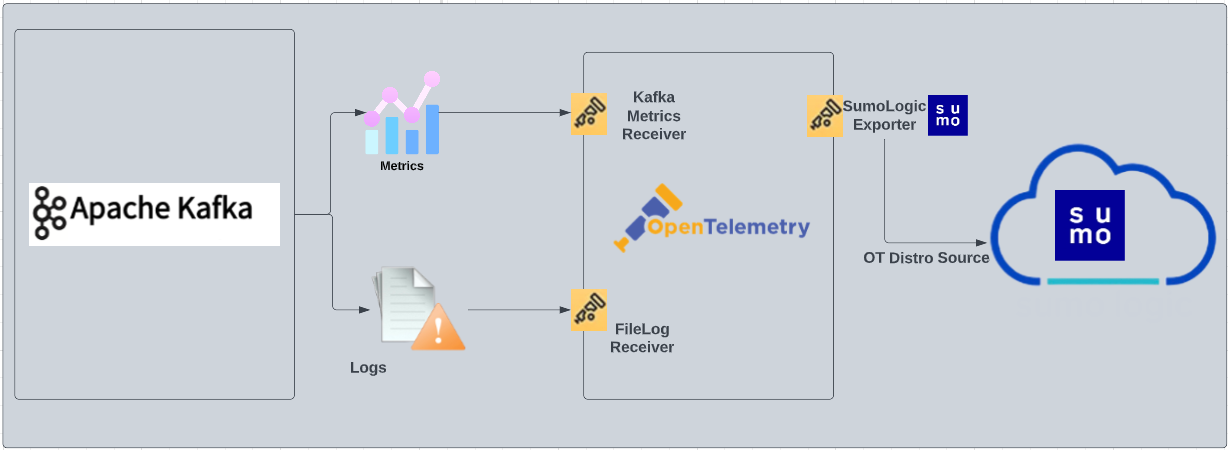
This App has been tested with following Kafka versions: 2.6.0, 2.7.0 and 3.1.2.
Log Types and Metrics
The Sumo Logic App for Kafka assumes:
- Kafka app supports the default logs format.
- For a list of metrics that are collected and used by the app, see Kafka Metrics.
Fields Creation in Sumo Logic for Kafka
Following are the Fields which will be created as part of KafkaApp install if not already present.
messaging.cluster.name. User configured. Enter a name to uniquely identify your Kafka cluster. This cluster name will be shown in the Sumo Logic dashboards.messaging.node.name. Has value ofhost name.messaging.system. Has fixed value ofkafka.sumo.datasource. Has fixed value ofkafka.
Prerequisites
Configure logging in Kafka: By default, Kafka logs (server.log and controller.log) are stored in the directory called /opt/Kafka/kafka_<VERSION>/logs. Make a note of this logs directory.
Collecting Logs, Metrics and Installing App for Kafka
The process to set up collection for Kafka data is done through the following steps.
Step 1: Set up OpenTelemetry Collector
If you want to use an existing OpenTelemetry Collector, you can skip this step by selecting the Use an existing Collector option.
To create a new Collector:
- Select the Add a new Collector option.
- Select the platform where you want to install the Sumo Logic OpenTelemetry Collector.
This will generate a command that you can execute in the machine environment you need to monitor. Once executed, it will install the Sumo Logic OpenTelemetry Collector.
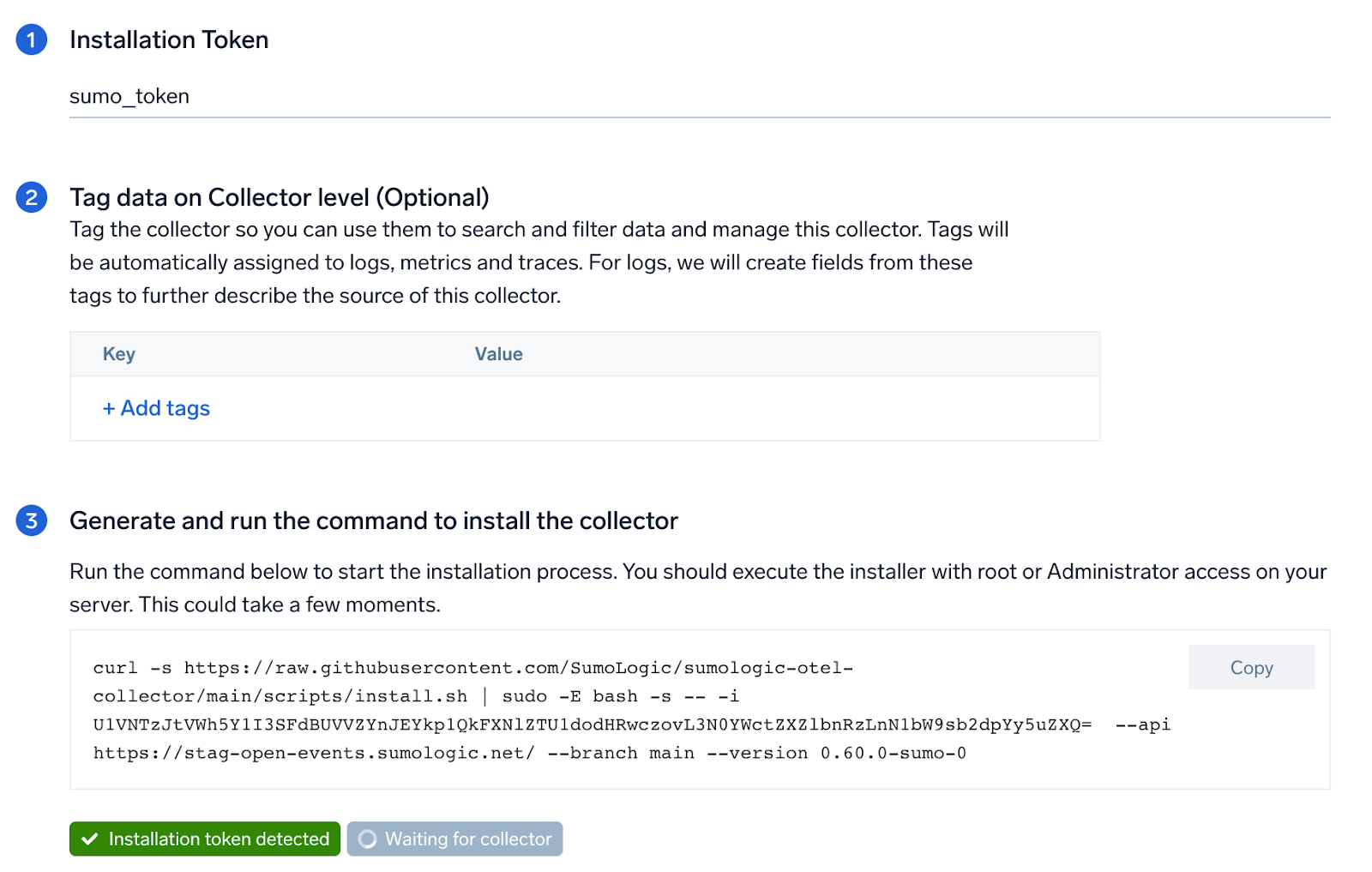
Step 2: Configure integration
In this step we will be configuring the yaml required for Kafka Collection.
Below is the input required:
- Endpoint. The URL of the broker endpoint (default:
localhost:9092). - Server File log Path. Enter the path to the Server log file for your Kafka instance.
- Controller file log path. Enter the path to the Controller log file for your Kafka instance.
- Fields.
messaging.cluster.nameUser configured. Enter a name to identify this Kafka cluster. This cluster name will be shown in the Sumo Logic dashboards.
Click on the Download YAML File button to get the yaml file.
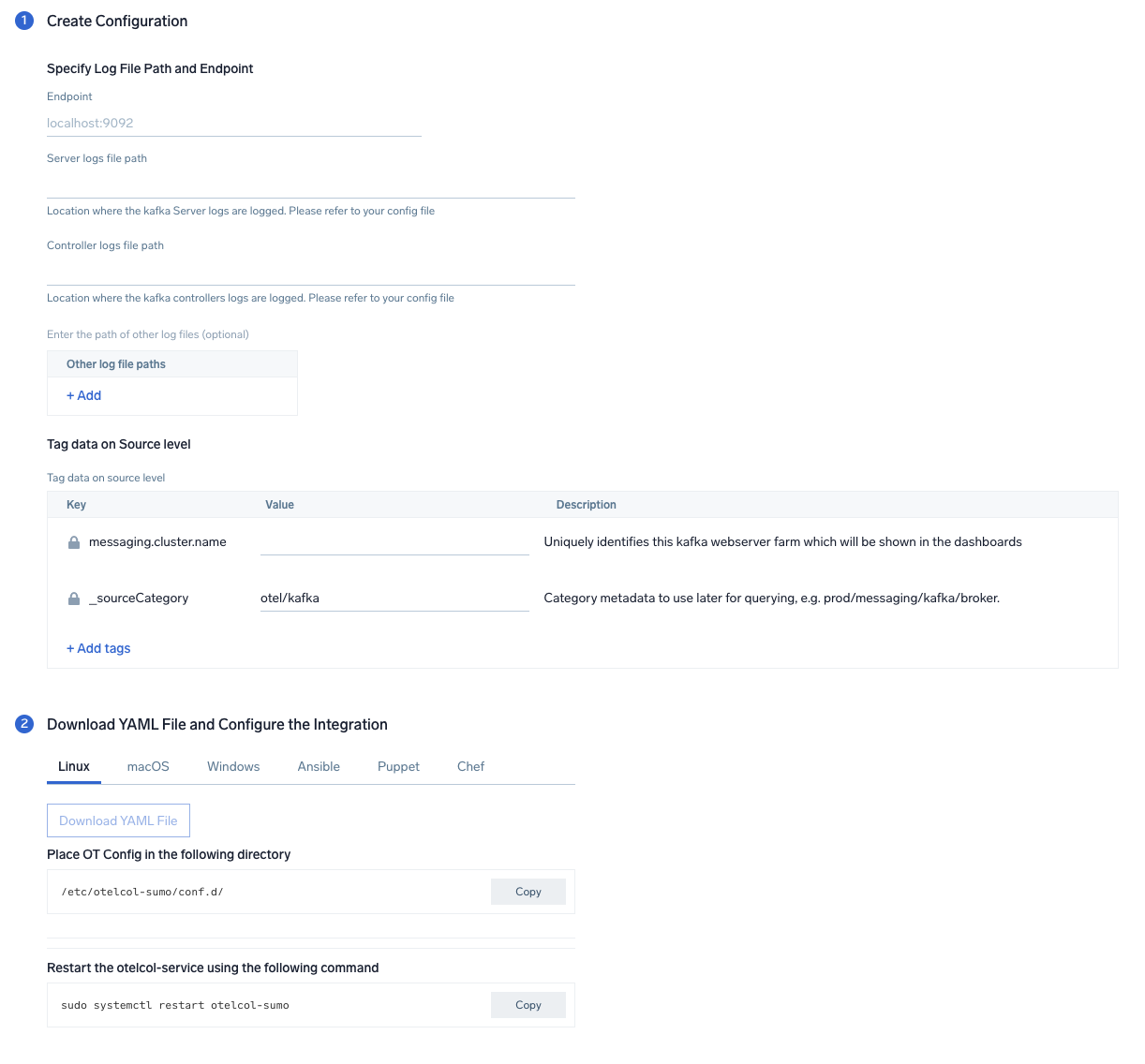
Step 3: Send logs and metrics to Sumo
Once you have downloaded the yaml file as described in the previous step, follow the below steps based on your platform.
- Linux
- Windows
- macOS
- Copy the yaml to the
/etc/otelcol-sumo/conf.d/folder for the Kafka instance which needs to be monitored. - Restart the collector using:
sudo systemctl restart otelcol-sumo
- Copy the yaml to the
C:\ProgramData\Sumo Logic\OpenTelemetry Collector\config\conf.dfolder in the machine which needs to be monitored. - Restart the collector using:
Restart-Service -Name OtelcolSumo
- Copy the yaml to the
/etc/otelcol-sumo/conf.d/folder in the Kafka instance which needs to be monitored. - Restart the otelcol-sumo process using the below command:
otelcol-sumo --config /etc/otelcol-sumo/sumologic.yaml --config "glob:/etc/otelcol-sumo/conf.d/*.yaml"
After successfully executing the above command, Sumo Logic will start receiving data from your host machine.
Click Next. This will install the app (dashboards and monitors) to your Sumo Logic Org.
Dashboard panels will start to fill automatically. It's important to note that each panel fills with data matching the time range query and received since the panel was created. Results won't immediately be available, but within 20 minutes, you'll see full graphs and maps.
Sample Log Messages
[2021-03-10 20:12:28,742] INFO [KafkaServer id=0]
started (kafka.server.KafkaServer)
Sample Queries
Log query
This sample Query is from the Events by Severity panel of the Kafka - Logs dashboard.
sumo.datasource=kafka messaging.cluster.name={{messaging.cluster.name}}
| json auto maxdepth 1 nodrop
| if (isEmpty(log), _raw, log) as kafka_log_message
| parse field=kafka_log_message "[*] * *" as date_time,severity,msg
| where severity in ("DEBUG", "INFO", "ERROR", "TRACE", "FATAL")
| count by severity
Metrics query
Sample query from Partition by Topics panel in Kafka - Metrics dashboard.
sumo.datasource=kafka metric=kafka.topic.partitions messaging.cluster.name={{messaging.cluster.name}} | sum by messaging.cluster.name,topic
Sample Metrics
"Query","metric","deployment.environment","host.name","messaging.cluster.name","messaging.node.name","messaging.system","os.type","sumo.datasource","topic","unit","latest"
"A","kafka.topic.partitions","prod","ip-10-0-18-47","kafkaotdemo","ip-10-0-18-47","kafka","linux","kafka","otlp_spans","{partitions}","1"
Viewing Kafka Dashboards
Filters with Template Variables: Template variables provide dynamic dashboards that rescope data on the fly. As you apply variables to troubleshoot through your dashboard, you can view dynamic changes to the data for a fast resolution to the root cause. For more information, see Filter with template variables.
Kafka - Overview
The Kafka - Overview dashboard gives you an at-a-glance view of your Kafka deployment across brokers, topics, partitions and consumer groups.
Use this dashboard to:
- Analyze trends across Partition Count and Unsync Partition Replica count metrics.
- Determine the number of brokers, partitions and topics across each cluster and ensure they match with expectations
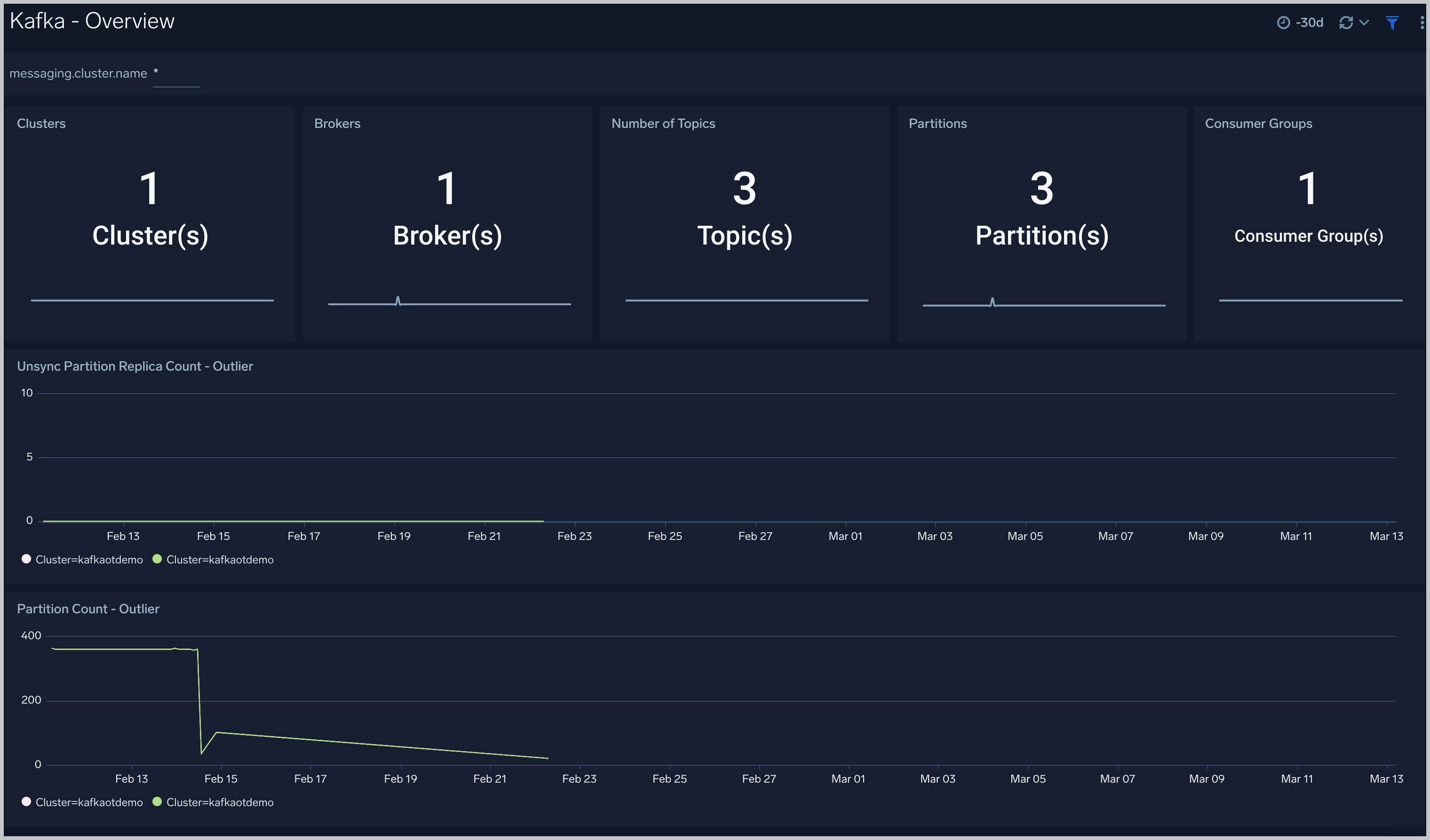
Kafka - Logs
The Kafka - Logs dashboard helps you quickly analyze your Kafka error logs across all clusters.
Use this dashboard to:
- Identify critical events in your Kafka broker and controller logs.
- Examine trends to detect spikes in Error or Fatal events.
- Monitor Broker added/started and shutdown events in your cluster.
- Quickly determine patterns across all logs in a given Kafka cluster.
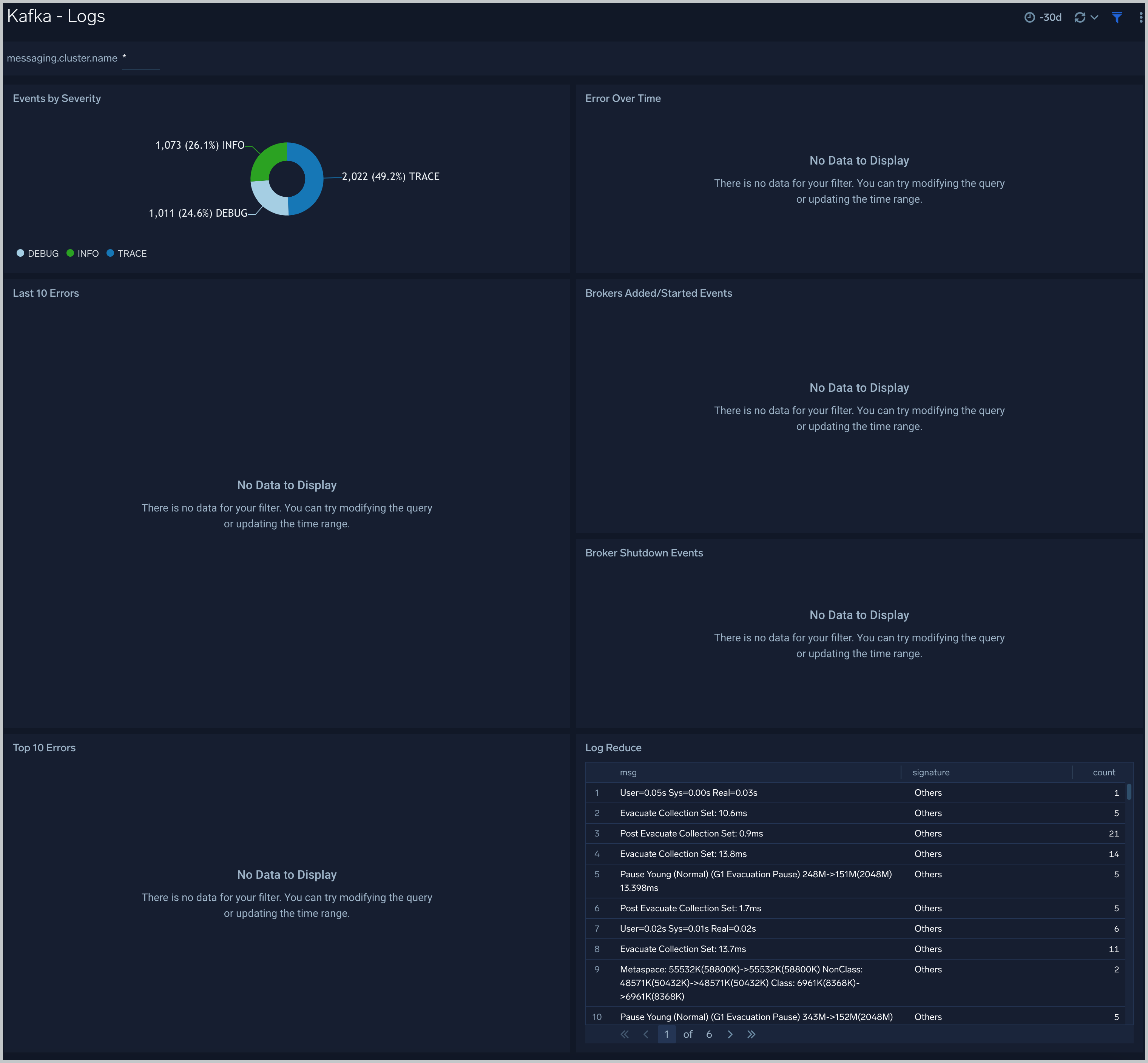
Kafka - Metrics
The Kafka - Metrics dashboard helps you to monitor unsynchronized partition replicas and consumer groups.
Use this dashboard to:
- Monitor consumer Group Lag by Topic.
- Identify unsynchronized partition replicas.
